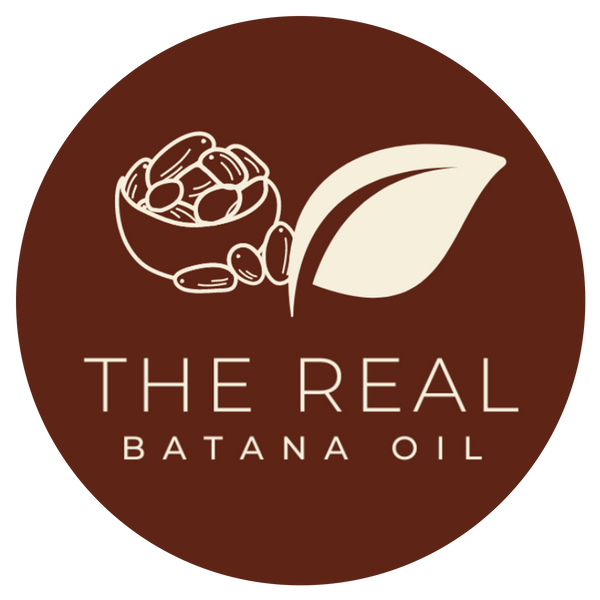If you're searching for "batana oil near me," you need to know how to distinguish fake from real ones. Driven by the fatty acids, antioxidants, and vitamins that Batana contains, the counterfeit versions are also on the rise because of the product’s high demand.
Good news is that you’re guaranteed to receive an authentic product when you purchase from The Real Batana Oil. We earn our customers' trust by providing an all-natural extract that actually works as advertised.
Key Takeaways:
- Authentic extracts have a rich brown to tan colour, a thick, buttery consistency, and a natural smoky, nutty aroma.
- Oils that are green, yellow, or too translucent can be diluted or artificial.
- Check for the INCI name (Elaeis Oleifera Kernel Oil), organic and cruelty-free certifications, and dark glass packaging.
Recognizing The Look of an Authentic Batana Oil
Colour and Look
Colours of rich brown or tan are typical for authentic products. It’s also nothing to worry about if it seems slightly reddish or orange because there are carotenoids and natural antioxidants in certain genuine batches. If it is too green, yellow, or translucent, then it raises red flags because it could be synthetic or blended.
Texture and How It Feels
It is neither runny nor too liquid. Rather, it is thick and viscous. It turns into a buttery or semi-solid consistency when exposed to colder temperatures, much like shea butter or coconut oil. Keep in mind that just because it is totally liquid at all temperatures doesn't necessarily mean it's phony. But it could mean it has been diluted with lighter carrier oils and isn't 100% natural extract.
- Tip: It should slide easily without feeling oily. When you compare it to coconut extract, which penetrates quickly, batana sits slightly longer on the skin or hair.
Aroma or Scent Profile
The natural, smokey, and nutty aroma of genuine products is one of the most telling signs that it is not synthetic or watered down.
Roasting gives it a warm, woodsy essence. A batch may carry the familiar aroma of dark chocolate or coffee beans. If the oil carries an overly flowery or perfumed scent, it likely contains synthetic additives. Heavy refining can also render it odorless and diminish its nutrient content.
Verifying Product Authenticity
|
INCI Name |
The International Nomenclature of Cosmetic Ingredients (INCI) name for batana is Elaeis Oleifera Kernel Oil. This should be displayed on the product's ingredient list to verify species. |
|
Certifications |
Look for organic, cruelty-free, and non-GMO certifications. |
|
Packaging |
Dark or opaque glass bottles are the best way to store authentic extracts because light diminishes their quality. There should be no typos or misspellings on the box. |
Additional Tips to Avoid Counterfeit Products
- Price Discrepancies: When a bargain sounds too good to be true, it most likely is. Items with super low prices may be fakes or watered-down versions of the real thing.
- Customer Reviews: You may learn a lot about the product's reliability and performance from reading reviews written by actual buyers.
- Seller Transparency: Be wary of anything that isn't completely clear or discloses too little information. The Real Batana Oil is happy to share specifics regarding how we source and extract our products.
Trusted Sources for Purchasing
If you want to buy pure batana oil that supports traditional extraction methods, go straight to those who work with people in Honduras. The Real Batana Oil is one such brand that provides real, handcrafted products that are 100% raw and unrefined.
- True batana oil is exclusively produced in Honduras. It only makes sense that products that say they're from somewhere else are fake. Always check the label for the country of origin.
Trust Only Verified Sources for Premium Batana Oil
Pay great attention to the product features at all times and check for certifications and reliable sources to verify authenticity. If you want much better hair and skin care, buy from The Real Batana Oil. Always prioritize quality over price to get the most out of genuine extract and all its benefits.
Frequently Asked Questions
Why does Batana oil sometimes have different scents?
Traditional extracts may contain palm nut residue or extraction sediment. These indicate minimally processed products, which is good. It’s okay to reheat and filter them before use if the sediment bothers you.
Why does my purchase smell different from my previous bottle?
Batana is hand-processed, so harvest season, palm nut roasting, and storage circumstances might affect its aroma. Some batches smell more toasted, while others are nuttier. This is normal and does not indicate lower quality if the oil's texture and colour remain consistent.
Do batana products expire?
Yes. Properly stored batana oil has a shelf life of around 12 to 18 months. You may tell when it has gone bad by its rancid or sour smell, sticky texture, and odd discolouration.
How to use batana oil?
Warm a small amount of this natural oil in your hands and gently massage it into scalp. For best results, leave it on for a few hours or overnight to deeply nourish hair. It works well as a wild growth hair oil for stronger strands over time. Apply to dry hair before washing or use a few drops daily to keep hair soft and hydrated.
What is Batana Oil good for?
Batana oil is a hair oil known for its nourishing properties. This promotes hair growth by strengthening the hair follicle while addressing hair thinning and supporting scalp health. Regular use can improve hair texture to make it softer and shinier.
Best for all hair types, including damaged hair, to restore moisture and reduce breakage. Adding it to your hair care routine can strengthen hair and guarantee overall vitality. Batana oil provides the nourishment needed to achieve optimal hair health.

